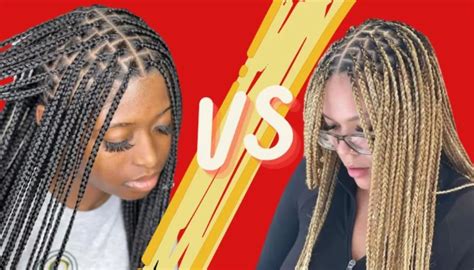Introduction
Protective hairstyles, such as box braids and knotless braids, are popular choices for women looking to enhance their natural hair, protect it from damage, and style it in various ways. However, there are distinct differences between these two techniques that can influence the look, feel, and longevity of the hairstyles. This comprehensive guide will delve into the nuances of box braids and knotless braids, empowering you to make an informed decision about the best choice for your hair and style preferences.

What is the Difference Between Box Braids and Knotless Braids?
Box Braids
- Created by dividing the hair into square sections and braiding the hair within each section from root to tip.
- The braids are tightly woven and have a slightly raised, box-like appearance.
- Offer versatility in styling, allowing for different sizes, lengths, and patterns.
Knotless Braids
- Similar to box braids, but the braid is created without using any knots at the root.
- The hair is fed into the braid continuously, creating a smooth, seamless look.
- Often result in less tension on the scalp, making them more comfortable to wear.
Key Differences Between Box Braids and Knotless Braids
| Feature | Box Braids | Knotless Braids |
|---|---|---|
| Knots at the Root | Yes | No |
| Tightness | High | Low |
| Comfort | Lower | Higher |
| Longevity | 4-6 weeks | 6-8 weeks |
| Versatility | High | Medium |
| Cost | Generally lower | Generally higher |
Pros and Cons of Box Braids and Knotless Braids
Box Braids
Pros:
- Versatile and customizable
- Offer a range of sizes and lengths
- Can create intricate patterns
- Relatively affordable
Cons:
- Can be heavy and cause scalp tension
- Requires regular maintenance to prevent frizz and breakage
- May not be suitable for all hair types
Knotless Braids
Pros:
- More comfortable to wear
- Reduces scalp tension
- Smoother and more natural-looking
- Lasts longer than box braids
Cons:
- Less versatile in styling
- Can be more expensive
- May not be as durable as box braids
Who Should Consider Box Braids?
- Individuals who want a versatile and customizable protective hairstyle
- Those who prefer a tightly braided look
- People who have thicker, textured hair that can withstand the weight and tension of box braids
Who Should Consider Knotless Braids?
- Individuals who prioritize comfort and want to avoid scalp tension
- Those with sensitive scalps or fine hair
- People who want a smoother, more natural-looking protective hairstyle
How to Choose the Right Protective Hairstyle for You
When deciding between box braids and knotless braids, consider the following factors:
- Hair Type: Box braids tend to be more suitable for thicker, textured hair, while knotless braids can be worn by individuals with all hair types.
- Comfort Level: Knotless braids offer reduced scalp tension, making them more comfortable to wear for extended periods.
- Versatility: Box braids provide more versatility in styling, allowing for different sizes, lengths, and patterns.
- Maintenance: Both box braids and knotless braids require regular maintenance to prevent frizz and breakage.
- Budget: Box braids are generally more affordable than knotless braids.
Common Mistakes to Avoid
- Overtightening Braids: Excessive tightness can cause scalp pain and hair breakage.
- Neglecting Maintenance: Regular washing, conditioning, and moisturizing are essential to keep the hairstyle healthy and frizz-free.
- Sleeping Without a Headwrap: Protect your braids by wearing a silk or satin headscarf or bonnet at night.
- Using Harsh Products: Avoid using harsh chemicals or abrasive products that can damage the hair and scalp.
FAQs
- Which hairstyle lasts longer? Knotless braids generally last longer than box braids, typically 6-8 weeks.
- Which hairstyle is more comfortable? Knotless braids are considered more comfortable due to their reduced scalp tension.
- Which hairstyle is more versatile? Box braids offer greater versatility in styling, with a wider range of sizes, lengths, and patterns.
- How often should I get my braids re-done? Both box braids and knotless braids typically need to be re-done every 4-6 weeks to maintain their appearance and prevent scalp buildup.
- Can I wash my braids? Yes, it is important to wash your braids regularly with a gentle shampoo and conditioner to remove dirt and product buildup.
- Can I use heat tools on my braids? Avoid using heat tools directly on your braids, as they can damage the hair. If you do use heat, apply it to a lower setting and keep it away from the roots.
Conclusion
Box braids and knotless braids are both popular protective hairstyles that offer distinct benefits and drawbacks. Box braids provide versatility and customization, while knotless braids prioritize comfort and longevity. When choosing between the two, consider your hair type, comfort level, style preferences, and budget to make the best decision for your individual needs. With proper maintenance and care, both box braids and knotless braids can enhance your natural hair, protect it from damage, and elevate your style to new heights.
